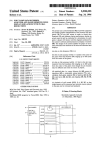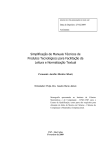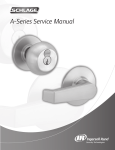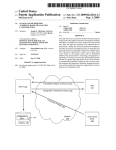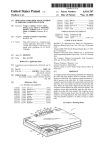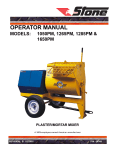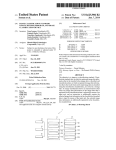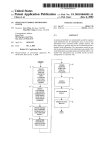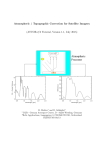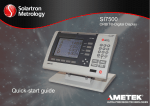Download Method and system for detecting and correcting errors in a
Transcript
US005842180A
United States Patent
[19]
Khanna et al.
[54]
Patent Number:
Date of Patent:
[11]
[45]
5,842,180
Nov. 24, 1998
Primary Examiner—FrantZy Poinvil
METHOD AND SYSTEM FOR DETECTING
AND CORRECTING ERRORS IN A
SPREADSHEET FORMULA
Attorney, Agent, or Firm—Jones & Askew, LLP
[57]
[75] Inventors: Karan Khanna, Clyde Hill; Edward
ABSTRACT
In association With a computer system, a method and system
A. Martinez, Redmond, both of Wash.
for detecting and correcting errors in a spreadsheet formula.
A token is created corresponding to each entry in the
formula. As the formula is constructed, each token is added
[73] Assignee: Microsoft Corporation, Redmond,
Wash.
Int. Cl.6 ...................................................... .. G06F 5/00
to the top of a formula token stack. When the formula is
completed, a parser parses the formula token stack starting
at the bottom of the stack and parsing each subsequent
token. By examining the tokens in the formula token stack
and their relationship to other tokens, the system determines
US.
Appl. No.: 625,535
Filed:
Mar. 28, 1996
707/504
Whether an error exists in the formula. If an error is found
Field of Search ...................... .. 705/30, 33; 707/503,
to exist in the formula, an error class code is assigned to the
707/504, 507, 508, 533, 538—540, 903,
error corresponding to the type of error. An error corrector
Cl.
............
. . . ..
705/30;
905
rule corresponding to the error class code is applied and
identi?es a correction for the error. After a correction for the
References Cited
U.S. PATENT DOCUMENTS
5,280,575
5,471,612
5,603,021
5,633,998
5,655,136
1/1994
11/1995
2/1997
5/1997
8/1997
Young et a1. ......................... ..
Schla?y ...... ..
Spencer ................................. ..
Schla?y ................................ ..
Morgan ................................. ..
707/504
395/700
345/604
395/180
382/182
error is identi?ed, the remainder of the formula token stack
is parsed to detect and correct any other errors. When the
entire formula token stack has been parsed and all detected
errors have been corrected, a dialog box is displayed con
taining the completely corrected formula.
24 Claims, 12 Drawing Sheets
102
USER ENTERS DATA
104
ADD TOKEN TO STACK
112‘,
110
111
114
GO TO FIRST TOKEN
1 16
152
PARSE CORRECTED
TOKEN
164
GO TO
NEXT TOKEN
PARSE TOKEN
{120
ER
141
YES
14a
N0
E RROR
OORRECTABLE
142
15
144
DISPLAY“GIVEUP"
146
(176
4
Raos'aaaa
“a A
DIALOG BOX
IDENTIFY
CORRECTION
174
181 YES
ENTERQWULA
14a
( 156
f
REPLACE TOKEN
h}
USER
EDlTS
w/ CORRECTED TOKEN
FORMULA
150
SET CORRECTlON
1180
USER
ACCEPTS
190 182
N0
U.S. Patent
Nov. 24, 1998
Sheet 1 0f 12
5,842,180
f
10
12
f
/
21
OPERATING
18
SYSTEM
/
APPLICATION
PROGRAM
14
L
CPU
r
20
K 16
HO
CONTROLLER
MEMORY
24
r
KEYBOARD /
MOUSE
FIGJ
/
22
DISPLAY
MONITOR
U.S. Patent
Nov. 24, 1998
Sheet 2 0f 12
5,842,180
(QUE
@wwD
mm
025m:3
@Engx>UoQ
NM
wm0.2h38mo52zi8wa
#93:02
Q500Mv+uo- r
:Ew
U.S. Patent
N0v.24,1998
Sheet 12 0f 12
5,842,180
700
@ rm
USER ENTERS DATA _
I
(104
ADD TOKEN TO STACK
112
‘A
GO TO FIRsT TOKEN
116
(
PARSE CORRECTED
TOKEN
IL
152
PARSE‘VTOKEN
:1
I
164
GO TO ’
NEXT TOKEN
121
\
13
’ CLA
140
141
YES
I
ERROR
N
CORRECTABLE
(144
APPLY RULE
BASED ON CODE
146
‘
DISPLAY "GIVEUP"
DIALOG BOX
(
IDENTIFY
181
CORRECTION
, 174
ENTER FORMULA
IN CELL
I
(148
I, ,156 @190 182
REPLACE TOKEN
2
UsER ED s
w/ CORRECTED TOKEN * FORMULA
150
SET CORRECTION
FLAG
A
5,842,180
1
2
METHOD AND SYSTEM FOR DETECTING
AND CORRECTING ERRORS IN A
SPREADSHEET FORMULA
entry can quickly become very dif?cult for the user, and the
probability of improperly entering such formulas is high.
Spreadsheet programs are popular among both
sophisticated, expert computer users as Well as ordinary,
novice users. Ordinary users may include homeoWners Who
use spreadsheet programs for maintaining household bud
TECHNICAL FIELD
The present invention relates generally to the entry of a
formula in a cell of a spreadsheet and, more speci?cally, to
a method and system for detecting and correcting errors in
a spreadsheet formula.
gets and personal ?nances. Other ordinary users may include
small business oWners Who use spreadsheets to perform
tasks such as tracking inventory, costs, sales, etc. Frequently,
10
BACKGROUND OF THE INVENTION
Spreadsheet programs are Widely-used application pro
grams that run on personal computers. Spreadsheet pro
grams are commonly used for budgets, forecasting, and
other ?nance-related tasks. In a spreadsheet program, data
and formulas are entered in ledger-like forms for analysis,
tracking, planning, or evaluations of the impacts of real or
15
These ordinary users of computers are usually not Well
versed in mathematics or computer syntax related to the
formulas that can be entered in the spreadsheet. Therefore,
the user may not remember the proper syntax and function
identi?ers required for various functions and therefore may
incorrectly enter the formula or may be forced to consult a
lengthy and complicated user’s manual to obtain the correct
proposed changes on data.
syntax.
Spreadsheet programs use roWs and columns of cells for
Current spreadsheet programs require that the user be
familiar With the complicated syntax needed to enter for
mulas in the spreadsheet. Thus, When the user Wishes to
the display of data. Depending on the program, a single
spreadsheet can contain anyWhere from thousands to mil
lions of cells. Some spreadsheet programs can also link one
spreadsheet to another spreadsheet that contains related
information and can update data in linked spreadsheets
automatically. Spreadsheet programs may also include
these tasks require the use of complicated formulas in the
spreadsheet program.
enter a formula in the spreadsheet, the user must manually
25
enter the formula including all proper syntax using the
keyboard Without being aided or prompted by the spread
sheet program.
When a user manually enters a formula, the probability of
macro facilities, and some can be used for creating and
sorting databases. For printed output, spreadsheet programs
usually provide graphing capabilities and a variety of for
matting options for printed pages and text, numeric values,
and captions and legends in graphs.
errors in the formula are high. Common errors include
improperly referencing other cells that are part of the
calculation, transposing cell addresses (identifying cell A1
as cell 1A), placing multiple operators together, and mis
Each roW and column in a spreadsheet is unique, so each
cell is uniquely identi?ed. Typically, each column is iden
matching parentheses. Also, incorrect spacing as Well as
ti?ed by a letter, and each roW is identi?ed by a number.
Thus, the cell located at the intersection of column A and
various other typographical errors can result in an improp
35
erly entered formula.
Current spreadsheet programs utiliZe a “function Wizard”.
The WiZard assists the user With the entry of parameters into
roW 1 is identi?ed as cell A1. Each cell is displayed as a
rectangular space that can hold text, numerical data, or a
formula that uses parameters, Which may comprise data in
an individual function but does not alloW the user to enter
other cells, to calculate a desired result. To ease
functions into the formula. Thus, the function WiZard, While
assisting the user With certain aspects of formula
construction, only assists the user after the proper syntax for
a function has been manually entered. Consequently, func
tion WiZards associated With current spreadsheet programs
computation, spreadsheet programs include built-in func
tions that perform standard calculations.
Such built-in functions may include simple arithmetic
functions such as addition (designated by the + character),
subtraction (designated by the — character), and multiplica
tion (designated by the * character). Many other functions
do not free the user from the dif?cult task of remembering
45
and entering the proper formula syntax. Thus, function
may be provided in the spreadsheet, including complex
WiZards do not assist the user in the construction of a
trigonometric functions to calculate the sine or cosine of a
formula in its entirety.
variable (designated by SIN and COS, respectively), and
Also, current function WiZards do not perform error
correction. Although current spreadsheet programs are able
to detect an improperly entered formula and generate and
functions to ?nd the natural logarithm and exponential value
of a variable (designated by LN and EXP, respectively).
Many other functions are provided by spreadsheet programs
to perform a Wide variety of calculations and data compari
display a message to the user, current programs do not detect
the precise error that is present Within the formula and also
do not provide a suggestion for the correction of the error.
If the user incorrectly enters a formula, current spreadsheet
sons.
A formula may be constructed Within a cell of the spread
sheet using one or more of the built-in functions combined 55 programs generate a generic error message to the user
indicating that the formula has been incorrectly entered.
With any other constants or variables. The proper syntax of
HoWever, the generic error message does not notify the user
of the type or location of the error. Therefore, Without
knoWing What type of error is present in the formula, a user
each formula is entered into the spreadsheet directly by the
user through the use of keystrokes on a keyboard. The
various functions available in spreadsheet formulas are
is left With the tedious and frustrating task of poring through
denoted by a particular character or characters. For example,
the very simple formula A1+B1 may be entered in the
spreadsheet When the user Wants to add the numbers located
in cells A1 and B1. More complicated formulas utiliZing
unfamiliar and complex functions require the user to manu
ally enter a function identi?er, such as SIN, COS, etc., in
65
a lengthy and complicated formula to detect Where the error
exists and editing the formula to correct the error. This
increases user frustration and decreases ef?ciency.
All of these problems associated With formula entry serve
not only to make the use of formulas in spreadsheets
order to use the function. Therefore, the user must memoriZe
time-consuming and inef?cient but also frustrating for the
the syntax required to correctly enter the formula. Formula
user. These problems may force a frustrated user to simply
5,842,180
3
4
give up and cease entering formulas in spreadsheet pro
grams. By not efficiently and effectively utilizing all of the
bene?ts that spreadsheet formulas provide, the user does not
maximize the capabilities of the spreadsheet program.
to a method and system for detecting and correcting errors
in a spreadsheet formula. Although the preferred embodi
ment of the present invention Will be described With respect
to spreadsheet programs, those skilled in the art Will recog
niZe that the present invention may be utiliZed in connection
SUMMARY OF THE INVENTION
With other softWare programs in Which mathematical or
other types of formulas are entered.
The present invention provides a method and system for
detecting and correcting errors that a user makes When
constructing a spreadsheet formula. When the user con
structs a formula in a spreadsheet, the present invention
creates a token corresponding to each entry in the formula.
As the user constructs the formula, each token is added to the
top of a formula token stack.
Turning ?rst to the nomenclature of the speci?cation, the
detailed description Which folloWs is represented largely in
terms of processes and symbolic representations of opera
tions by conventional computer components, including a
central processing unit (CPU) associated With a general
purpose computer system, memory storage devices for the
When the user has completed construction of the formula,
a parser parses the formula token stack starting at the bottom
of the stack and parsing each subsequent token. By eXam
ining the tokens in the formula token stack and their rela
tionship to other tokens, the present invention determines
15
CPU, and connected pixel-oriented display devices. These
operations include the manipulation of data bits by the CPU
and the maintenance of these bits Within data structures
resident in one or more of the memory storage devices. Such
Whether an error eXists in the formula.
data structures impose a physical organiZation upon the
collection of data bits stored Within computer memory and
represent speci?c electrical or magnetic elements. These
symbolic representations are the means used by those skilled
in the art of computer programming and computer construc
tion to most effectively convey teachings and discoveries to
The present invention maintains a list of types of common
errors that eXist in spreadsheet formulas. If an error is found
to eXist in the formula, the present invention determines the
type of error and assigns an error class code to the error
corresponding to the type of error.
Based on the error class code assigned to the error, the
others skilled in the art.
present invention determines Whether a correction to the 25
For the purposes of this discussion, a process is generally
conceived to be a sequence of computer-executed steps
error can be identi?ed. The invention maintains an error
corrector rule for each error class code identifying the
common types of errors. The invention applies the appro
leading to a desired result. These steps generally require
physical manipulations of physical quantities. Usually,
priate error corrector rule based on the error class code
assigned to the error. The error correction rule identi?es a
correction for the error.
After a correction for the error is identi?ed, the remainder
though not necessarily, these quantities take the form of
electrical, magnetic, or optical signals capable of being
stored, transferred, combined, compared, or otherWise
manipulated. It is conventional for those skilled in the art to
of the formula token stack is parsed to detect and correct any
other errors. When the entire formula token stack has been
parsed and all detected errors have been corrected, a dialog
refer to these signals as bits, values, elements, symbols,
35
boX is displayed containing the completely corrected for
mula. The user may select buttons in the dialog boX to enter
characters, terms, numbers, records, ?les or the like. It
should be kept in mind, hoWever, that these and similar
terms should be associated With appropriate physical quan
tities for computer operations, and that these terms are
the corrected formula in the spreadsheet or manually edit the
incorrect formula. If no suggested correction is identi?ed for
the error, a dialog boX is displayed prompting the user to
return to the formula, Where the present invention highlights
merely conventional labels applied to physical quantities
that eXist Within and during operation of the computer.
It should also be understood that manipulations Within the
computer are often referred to in terms such as adding,
the error so that the error can be more easily identi?ed and
comparing, moving, etc. Which are often associated With
manual operations performed by a human operator. It must
corrected by the user.
If the error in the formula is found not to be one of the
be understood that no involvement of a human operator is
type of errors included in the list of common errors, the 45
necessary or even desirable in the present invention. The
present invention does not attempt to identify a correction
and displays a dialog boX on the display screen prompting
the user to manually edit the formula.
operations described herein are machine operations per
formed in conjunction With a human operator or user that
interacts With the computer. The machines used for perform
ing the operation of the present invention, as Will be
understood, include general purpose digital computers or
other similar computing devices.
In addition, it should be understood that the programs,
BRIEF DESCRIPTION OF THE DRAWINGS
FIG. 1 is a block diagram of a computer system on Which
the present invention is implemented.
FIGS. 2A—C are eXamples of display screens displayed in
accordance With the present invention When all errors in the
formula are correctable.
processes, methods, etc. described herein are not related or
55
FIGS. 3A—F are eXamples of display screens displayed in
accordance With the present invention When all errors in the
formula are not correctable.
FIG. 4 is an eXample of a display screen displayed in
accordance With the present invention When none of the
errors in the formula is correctable.
FIG. 5 is a How chart shoWing the method of detecting and
correcting errors in a formula in a spreadsheet.
DETAILED DESCRIPTION
Turning neXt to the ?gures, the preferred embodiment Will
noW be described in detail. The present invention is directed
limited to any particular computer or apparatus. Rather,
various types of general purpose machines may be used With
programs constructed in accordance With the teachings
described herein. Similarly, it may prove advantageous to
construct specialiZed apparatus to perform the method steps
described herein by Way of dedicated computer systems With
hard-Wired logic or programs stored in nonvolatile memory,
such as read only memory.
Furthermore, it should be understood that there is a
distinction betWeen the methods, steps, or operations com
65
pleted by a computer and the method of computation itself.
The present invention does not involve a method of com
putation. Instead, the present invention relates to methods,
5,842,180
5
6
processes, steps, or operations for a computer and the
entered in cell A5 contains several errors. The correct
processing of electrical or other physical signals to generate
desired physical signals and to display results and interac
formula should be entered as (A1+A2)*(A3/(10+A4)).
HoWever, the spreadsheet of FIG. 2A shoWs that the user has
tions.
Turning noW to the draWings, in Which like numerals
entered the error-?lled formula (A1+/A2)*[3A/10+A4—.
Therefore, the user has made ?ve errors When entering the
formula. The errors are: multiple operators, i.e., operator “/”
folloWs operator “+”, a bracket “[” instead of an open
parentheses “(”, the bracket character that should be an open
indicate like elements throughout the several ?gures, FIG. 1
illustrates a computer system on Which the preferred
embodiment of the present invention is implemented. Refer
ring to FIG. 1, the computer system is generally shoWn at 10.
The computer system includes an operating system 12, a
central processing unit (CPU) 14, a memory storage device
parentheses is unmatched, a transposed character reference,
10
16, an application program or program module 18, and an
input/output (I/O) controller 20. The above referenced com
ponents are operatively connected by a system bus 21.
Connected to the computer is a display 22, preferably a
video monitor, for displaying images to a user, and an input
means 24, preferably a keyboard and mouse, for alloWing a
user to input data into the computer system. The application
program or program module 18 includes a spreadsheet
program that permits the user to enter formulas into a cell or
15
i.e. “3A” instead of “A3”, and an extra trailing operator “—”.
When the user has completed entering the formula, the
check box 32 is selected. If the formula is entered correctly,
the present invention enters the formula and displays the
result of the formula in the current cell. HoWever, if the
formula contains an error, the present invention detects the
error and displays a dialog box to prompt the user to correct
the error. It should be understood that the method of the
present invention can be accessed by any suitable means
consistent With the graphical user interface associated With
20
the computer system on Which it is implemented. Therefore,
created When a user constructs a formula Within a spread
sheet. Typically, a user enters a formula into a cell in the 25
the present invention should not be construed to be limited
only to use With the graphical user interface elements
described herein.
Because the formula entered in cell A5 in FIG. 2A
contains errors, the dialog box 36, as seen in FIG. 2B, is
spreadsheet using the standard method of entering the
required syntax using a keyboard. Alternatively, the user
rected formula 38 and also displays a textual message that
cells of a spreadsheet.
The present invention comprises programming Within the
application program that detects and corrects errors that are
displayed. The dialog box 36 displays the completely cor
may enter the formula using the method described in
co-pending US. patent application Ser. No. 08/558,820
entitled “METHOD AND SYSTEM FOR CONSTRUCT
ING A FORMULA IN A SPREADSHEET”, noW pending
directs the user to either accept the corrected formula or
30
assigned to Microsoft Corporation, Redmond, Wash., also
the assignee of the present invention. The method and
system of the present invention Will be described herein With
reference to the standard method of formula entry, hoWever,
to the user, the OK button 40 is selected. When the OK
35
it should be understood that the error detection and correc
tion features of the present invention may be utiliZed regard
less of the manner in Which the user enters the formula into
the spreadsheet.
When the user is running the spreadsheet program on the
computer system, a spreadsheet such as that shoWn in FIG.
2A is displayed on the display 22. The spreadsheet includes
a plurality of individual cells, in columns identi?ed from left
to right in alphabetical order and roWs identi?ed from top to
bottom in numerical order. Near the top of the display is a
manually edit the incorrect formula. If the corrected formula
38 is not acceptable, the user selects the Cancel button 39.
When the Cancel button 39 is selected, the dialog box 36 is
removed from the display and the user manually edits the
formula in the cell. If the corrected formula 38 is acceptable
40
button is selected, the corrected formula is substituted for the
incorrect formula in the current cell, as shoWn in FIG. 2C.
When the correct formula is entered in the cell, the cell
displays the result of the formula. As seen in FIG. 2C, the
formula entered in cell A5, displayed in the formula bar 30,
and the spreadsheet calculates a result for the formula. The
resultant numerical value of the formula is displayed in
current cell A5 .
45
formula bar 30.
FIGS. 2A—C shoW the sequence of displays that are
displayed When an error-?lled formula is completely cor
rectable by the method of the present invention. HoWever,
all errors in a formula may not be able to be corrected by the
present invention. An example of such a formula is
described With reference to FIGS. 3A—F.
In FIG. 3A, the user has entered the formula 1A**5)+
2A2. The correct formula should be 12*5+A22. When the
user enters the formula and selects the check box 32, the
The user may enter data into the current cell in the
spreadsheet. Such data may include text, numbers, or for
mulas. The current cell in the spreadsheet is identi?ed by a
thickened border around the periphery of the cell. In FIG.
2A, the current cell is identi?ed as cell A5. Each of cells A1,
A2, A3, and A4 contain numerical data.
dialog box 44 is displayed. The dialog box 44 is displayed
When the present invention detects an error or errors in the
An example of a formula that a user may enter in the
current cell is shoWn in FIG. 2A. When a formula is entered 55 formula but cannot identify a completely corrected formula.
in the current cell, the characters entered by the user are
displayed both Within the current cell and Within the formula
The dialog box displays a textual message 46 that informs
bar 30. It should be understood that, for the examples
button 48 is selected, the dialog box is removed from the
display screen and the formula is displayed in the current
cell.
the user that an error exists in the formula. When the OK
described herein, all formulas entered in a cell of a spread
sheet are preceded by the character “=”. HoWever, the
60
present invention is in no Way limited only to formulas that
The ?rst error in the formula, as detected from left to
require this leading character and the folloWing description
right, is highlighted to alloW the user to take notice of the
error. In the formula of FIG. 3B, the error that is highlighted
is the character “A” that folloWs the character “1”. This
of spreadsheet formulas Will make no further reference to
the leading “=” character.
In cell A5, the user has entered a formula utiliZing
multiple functions, multiple cell references, and parentheses
to group particular data together. HoWever, the formula
65
sequence of characters is identi?ed by the present invention
as being a cell reference that has been transposed. HoWever,
in the correct formula, the characters “1A” should be the
5,842,180
8
7
number “12”. Therefore, the user manually edits the formula
by changing the characters “1A” to “12”. The user may
continue to manually edit the formula, or the user may select
the check button 32.
When the check button is selected, the present invention
again determines Whether errors exist in the formula.
Because another error exists in the formula, the dialog box
50 is displayed, as shoWn in FIG. 3C. The dialog box 50
provides a textual message relating to the error and prompts
the user to edit the formula by selecting the OK button 52.
When the OK button is selected, the dialog box 50 is
After the user has completed constructing the formula and
the formula token stack has been created, the user enters the
formula in the current cell by selecting the check box. When
the check box is selected, the present invention causes the
formula token stack to be parsed. The present invention
utiliZes a standard spreadsheet parser that uses standard
10
removed from the screen, and the error in the formula is
highlighted in the current cell. The present invention high
lights the second multiplication operator, “*”. The user
manually deletes the multiple operator and again selects the
check box.
parsing techniques Well knoWn to those skilled in the art.
The parser examines each token in the formula token
stack beginning With the ?rst token, i.e., the token on the
bottom of the stack. The present invention includes a list of
proper combinations of tokens for a formula. Therefore, the
parser can determine Whether the formula contains a syntax
error or a cell reference error. For example, When the parser
detects a token representing an operator that folloWs a
15
The present invention again determines Whether another
previous token representing an operator, the method of the
present invention determines that multiple operators are
located adjacent to one another. Such a combination of
operators is a syntax error in the formula.
error exists in the formula. Because an improper parentheses
character is included in the formula, a dialog box 56, as
shoWn in FIG. 3D, is displayed that describes the error and
prompts the user to select the OK button 58 to manually edit
the formula. The user then selects the OK button and the
dialog box is removed form the screen. The parentheses
Many other syntax errors exist. The present invention
parses the formula token stack to locate the syntax and cell
reference errors described beloW in Table 1.
TABLE 1
character is then highlighted in cell A5, thereby informing
the user of the error. The user then deletes the parentheses 25
Types of Formula Errors
and selects the check button.
The present invention then examines the formula and
Unmatched parentheses
determines that a ?nal error exists. The invention determines
Extra operators in the beginning
that the character sequence “2A2” is a transposed cell
reference that should be “A22”. The invention displays the
Trailing operator Without operand
Brackets used as parentheses,
Implied multiplication
Extra decimal point
dialog box 60, shoWn in FIG. 3E, Which displays the
“X” used as multiplication operator
completely corrected formula and prompts the user to accept
the corrected formula or reject the corrected formula. If the
Multiple operators
user selects the Cancel button 64, the user can again manu
Misplaced colon in range
Transposed cell reference
ally edit the formula displayed in cell A5. If the user selects
the OK button 62, the invention replaces the incorrect
formula in the current cell With the completely corrected
formula displayed in the dialog box 60, and the result of the
formula is calculated and displayed in cell A5, as shoWn in
Comma as separator
35
Extra space in cell reference
Extra space between numbers
Using semicolon instead of colon in range
Extra space between function name and parentheses
Commas at end of formula
FIG. 3F.
When the present invention detects an error in the
formula, the present invention assigns an error class code to
the error. For example, each type of error listed in Table 1
has a unique error class code associated thereWith.
Alternatively, another dialog box may be displayed When
the present invention detects an error in a formula but cannot
determine Where the error is located or What a suggested
correction should be. This is shoWn in FIG. 4, Where the user
has entered the formula (A)+(A) in cell A4. The correct
formula should be A1+A2. The present invention examines
the formula and determines that the formula is incorrectly
45
Therefore, the present invention not only detects the pres
ence of an error in a formula, but also identi?es the type of
error that exists.
entered because there are no numbers or valid cell references
For each error class code, the present invention includes
in the formula. In this case, the present invention displays a
an error corrector rule. Each error corrector rule includes a
“give up” dialog box 70 that informs the user that the
method that determines Whether a correction can be identi
formula contains an error and alloWs the user to select the
?ed. For example, the formula shoWn in the spreadsheet of
OK button 72 to return to the formula to manually edit it.
When a formula is constructed, a token is created for each
character that is entered in the function. The tokens are
arranged in a formula token stack. When the user enters the
?rst character in the formula, a token is created correspond
ing to the ?rst character and is placed on the bottom of the
FIGS. 3A—F includes a cell reference that should be entered
as “A22”, but is incorrectly entered as “2A2”. A token is
created for each character and is placed on the formula token
55
stack. The parser parses the formula token stack, and the
method of the present invention compares the combination
of tokens to a list of acceptable combinations to determine
formula token stack. For each subsequent character that is
entered, a corresponding token is created and is placed on
that the character sequence “2A2” is an error. From the
top of the formula token stack. Thus, the token correspond
error is a transposed cell reference.
ing to the ?rst character entered in the formula is on the
bottom of the formula token stack, and the token corre
sponding to the last character in the formula is on top of the
stack. If a character in the middle of the formula is subse
An error class code corresponding to the type of error, i.e.,
a transposed cell reference, is generated. The error corrector
rule associated With the error class code is then applied to the
quently replaced by another character, the token for the
replacement character is inserted into the formula token
stack in place of the token for the replaced character.
combination of tokens, the invention determines that the
error. The error corrector rule examines the tokens associ
65
ated With the error to identify and suggest a correction to the
error. For example, the error corrector rule for transposed
cell references rearranges the characters of the incorrect cell
5,842,180
9
10
reference to make the valid cell reference “A22”. Therefore,
the present invention replaces the error “2A2” with the
exists, the method follows “yes” branch 121 to step 134. If
suggested correction “A22”.
“no” branch 122 and proceeds to step 130.
In a similar manner, other appropriate error corrector rules
are applied to each type of error identi?ed in the formula. A
summary of the corrective measures applied by each error
At step 130, it is determined whether a cell reference error
exists in the formula. If no cell reference error exists, the
no syntax error exists in the formula, the method follows
corrector rule is provided in Table 2.
TABLE 2
10
Results Obtained from Application of Error Corrector Rules
Error:
Correction:
Unmatched parentheses
Add closing/opening parentheses for unmatched
opening/closing parentheses. For multiple open
parentheses, add closing parentheses at the end of the
formula. For unmatched closing parentheses, delete
When either a syntax error or a cell reference error has
been detected at steps 120 and 130, respectively, an error
class code is set at step 134. Each error class code is
associated with a predetermined type of error. There is one
error class code associated with each type of error.
The method then proceeds to step 140 where it is deter
closing parentheses.
Error:
Correction:
Brackets used as parentheses
Replace opening/closing brackets with opening/closing
parentheses.
Error:
Correction:
Extra operators in the beginning
Delete extra operators at the beginning of the formula.
Error:
Correction:
Error:
Trailing operator without operand
Delete trailing operators without operands.
Implied multiplication
Correction:
Add multiplication operator when a number/cell
reference is followed by a parentheses. Add multiplication
operator when a closed parentheses is followed by a
number/cell reference.
Extra decimal point
Remove extra decimal points within a number starting from
the right side of the number until the number is valid.
“X” used as multiplication operator
Replace character “X” with multiplication operator “*”.
Error:
Correction:
Error:
Correction:
Error:
Correction:
mined whether the detected error is correctable. The error is
deemed to be correctable if there exists an error corrector
rule associated with the error class code. If an error corrector
25
at step 146 and, at step 148, the token corresponding to the
correction is inserted into the formula token stack in place of
the token corresponding to the error. A correction ?ag is set
at step 150. The corrected token is parsed at step 152, and
the method then returns to step 120.
Multiple operators
Delete multiple operators concatenated together from right
Comma as separator
Correction:
Delete comma used as a separator in a number.
Error:
Misplaced colon in range
rule exists for the assigned error class code, the error is
correctable, and the method follows “yes” branch 141 to step
144. At step 144, the appropriate error corrector rule is
applied to the error in the formula. A correction is identi?ed
to left.
Error:
method follows “no” branch 132 to step 160. At step 160, it
is determined whether the parsed token was the last token in
the formula token stack. If the end of the formula token stack
has not been reached, the method follows “no” branch 162
to step 164. At step 164, the next token is selected, and the
method returns to step 116 for parsing the token. If all of the
tokens in the formula token stack have been parsed, as
determined at step 160, the method follows “yes” branch
161 to step 170.
If it is determined at step 140 that the error is not
35
correctable, the method follows “no” branch 142 and pro
Correction:
Delete misplaced colon in a range of cell references.
ceeds to step 154 where a “give up” dialog box is displayed.
Error:
Correction:
Transposed cell reference
Reverse characters in transposed cell address.
Error:
Correction:
Error:
Correction:
Extra space in cell reference
Delete spaces between cell references.
Extra space between numbers
Delete spaces between numbers.
Using semicolon instead of colon in range
Replace semicolon in range with colon.
Extra space between function name and parentheses
Delete space between function name and parentheses.
Comma at end of formula
The user then manually edits the formula at step 156, and the
method then proceeds to step 148.
After the entire formula token stack has been parsed, as
Error:
Correction:
Error:
Correction:
Error:
Correction:
Delete comma at the end of formula.
The method of detecting and correcting errors in a spread
sheet formula, as described above, is also described with
reference to the How chart of FIG. 5. The method begins at
100. At step 102, the user enters data including a number,
cell reference, or function into the formula. At step 104, a
token corresponding to the character is created and is added
to the top of the formula token stack. At step 110, it is
determined whether the formula has been completed. As
described above, this is determined when the user selects the
determined at step 160, the method determines, at step 170,
45
been set, the method follows “yes” branch 171 to step 176.
At step 176, the corrected formula is displayed to the user in
a dialog box. At step 180, it is determined whether the user
accepts the corrected formula. If not, the method follows
“no” branch 182 to step 156. If the user accepts the corrected
formula, the method follows “yes” branch 181 to step 174
where the formula is entered in the cell.
In summary, the present invention provides a method and
55
system that detects and corrects a formula entered in a cell
of a spreadsheet. A token is created corresponding to each
entry in the formula. As the formula is constructed, each
token is added to the top of a formula token stack. When the
formula is completed, a parser parses the formula token
stack starting at the bottom of the stack and parsing each
check button on the display screen, or any other method
provided by the spreadsheet application program. If the
formula has not been completed, the method follows “no”
branch 112 and returns to step 102, where the user enters
more data to the formula. If the formula has been completed,
subsequent token. By examining the tokens in the formula
token stack and their relationship to other tokens, the present
the method follows “yes” branch 111 to step 114.
At step 114, the ?rst token, i.e., the token on the bottom
of the formula token stack is selected. At step 116, the token
is parsed using standard spreadsheet parsing techniques. At
whether a correction ?ag has been set. If a correction ?ag has
not been set, meaning that the formula contains no
corrections, the method follows “no” branch 172 to step 174.
At step 174, the formula is entered in the cell. The method
then terminates at 190.
If it is determined at step 170 that a correction ?ag has
invention determines whether an error exists in the formula.
If an error is found to exist in the formula, an error class code
step 120, the method of the present invention determines
is assigned to the error corresponding to the type of error. An
error corrector rule corresponding to the error class code is
whether a syntax error exists in the formula. If a syntax error
applied and identi?es a correction for the error. After a
65
5,842,180
11
12
correction for the error is identi?ed, the remainder of the
formula token stack is parsed to detect and correct any other
errors. When the entire formula token stack has been parsed
and all detected errors have been corrected, a dialog box is
10. The system of claim 9 further comprising means for
displaying the corrected formula in a dialog box that alloWs
the user to either accept the corrected formula for entry into
the cell or manually edit the incorrect formula.
11. The system of claim 9 Wherein each error class code
is associated With a predetermined type of error.
12. The system of claim 11 Wherein the error class code
is assigned only for an error that is of a predetermined type.
13. The system of claim 9 Wherein the error corrector rule
displayed containing the completely corrected formula.
From the foregoing, it Will be appreciated that the pre
ferred embodiment of the present invention overcomes the
draWbacks of the prior art described hereinabove. From the
description of the preferred embodiment, equivalents of the
elements shoWn therein Will suggest themselves to those
skilled in the art and Ways of constructing other embodi
ments of the present invention Will suggest themselves to
practitioners of the art. Therefore, the scope of the present
invention is to be limited only by the claims beloW.
What is claimed is:
10
is one of a stored list of error corrector rules and each error
corrector rule is associated With a predetermined error class
code.
14. The system of claim 9 further comprising displaying
15
a dialog box prompting the user to manually edit the formula
1. In association With a computer system, a method for
detecting and correcting an error in a formula in a cell of a
if the error is not one of a predetermined type.
spreadsheet, comprising the steps of:
a dialog box prompting the user to manually edit the formula
15. The system of claim 9 further comprising displaying
if the error corrector rule cannot identify a correction.
creating a token for each character entered in the formula;
adding each token to a formula token stack;
for each token in the formula token stack, parsing the
16. The system of claim 15 Wherein the error in the
formula displayed in the cell is highlighted.
17. A computer-readable medium having computer
token to determine Whether an error exists in the
formula; and
if an error exists in the formula that is one of a predeter
25
mined type of error:
assigning an error class code based on the type of error;
and
applying an error corrector rule to identify a correction
to the error.
if an error exists in the formula that is one of a predeter
mined type of error:
manually edit the incorrect formula.
assigning an error class code based on the type of error;
3. The method of claim 1 Wherein the error class code is
35
to the error.
18. The computer-readable medium of claim 17 having
further computer-executable instructions for performing the
step of displaying the corrected formula in a dialog box that
is one of a plurality of error corrector rules and each error
corrector rule is associated With a predetermined error class
alloWs the user to either accept the corrected formula for
entry into the cell or manually edit the incorrect formula.
19. The computer-readable medium of claim 17 Wherein
code.
6. The method of claim 1 further comprising displaying a
dialog box prompting the user to manually edit the formula
45
7. The method of claim 1 further comprising displaying a
dialog box prompting the user to manually edit the formula
20. The computer-readable medium of claim 19 Wherein
predetermined type.
21. The computer-readable medium of claim 17 Wherein
displayed in the cell is highlighted.
the error corrector rule is one of a plurality of error corrector
rules and each error corrector rule is associated With a
9. A computer system, including a program module that
displays cells of a spreadsheet on a display, for detecting and
predetermined error class code.
correcting an error in a formula in a cell of said spreadsheet,
55
manually edit the formula if the error is not one of a
means for adding each token to a formula token stack;
means for parsing each token in the formula token stack
to determine Whether an error exists in the formula;
means for storing a list of predetermined types of errors;
and
predetermined type.
23. The computer-readable medium of claim 17 having
further computer-executable instructions for performing the
step of displaying a dialog box prompting the user to
manually edit the formula if the error corrector rule cannot
identify a correction.
means for assigning an error class code based on the type
means for applying an error corrector rule to identify a
correction to the error.
22. The computer-readable medium of claim 17 having
further computer-executable instructions for performing the
step of displaying a dialog box prompting the user to
the formula;
of error, if the error is one of said predetermined types;
and
the error class code is one of a plurality of error class codes
and each error class code is associated With a predetermined
type of error.
the error class code is assigned only for an error that is of a
if the error corrector rule cannot identify a correction.
8. The method of claim 7 Wherein the error in the formula
means for creating a token for each character entered in
and
applying an error corrector rule to identify a correction
code is associated With a predetermined type of error.
4. The method of claim 3 Wherein the error class code is
assigned only for an error that is of a predetermined type.
5. The method of claim 1 Wherein the error corrector rule
comprising:
creating a token for each character entered in the formula;
adding each token to a formula token stack;
for each token in the formula token stack, parsing the
formula; and
the corrected formula in a dialog box that alloWs the user to
either accept the corrected formula for entry into the cell or
if the error is not one of a predetermined type.
comprising:
token to determine Whether an error exists in the
2. The method of claim 1 further comprising displaying
one of a plurality of error class codes and each error class
executable instructions for detecting and correcting an error
in a formula in a cell of a spreadsheet by performing steps
65
24. The computer-readable medium of claim 23 Wherein
the error in the formula displayed in the cell is highlighted.
*
*
*
*
*



















